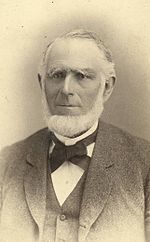Abraham O. Smoot | |
|---|---|
 Photo of A. O. Smoot by C. R. Savage | |
| Born | Abraham Owen Smoot February 17, 1815 |
| Died | March 6, 1895 (aged 80) |
| Monuments | Smoot Administration Building, Brigham Young University |
| Nationality | American |
| Title | Mayor of Salt Lake City, Utah; Mayor of Provo, Utah |
| Term | 1857–1866; 1868–1881 |
| Predecessor | Jedediah M. Grant |
| Successor | Daniel H. Wells |
| Spouses |
|
| Children | 24 (biological) 11 (adopted) |
| Signature | |
Abraham Owen Smoot (February 17, 1815 – March 6, 1895) was an American pioneer, businessman, religious leader, and politician. He spent his early life in the Southern United States and was one of seven children. After being baptized a member of the Church of Christ, predecessor to the Church of Jesus Christ of Latter-day Saints (LDS Church), Smoot served as a missionary in Kentucky, Tennessee, South Carolina, and England. He received no formal education, but learned to read as a child and later attended the School of the Prophets in Kirtland, Ohio. Like other early members of the LDS Church, Smoot practiced plural marriage, eventually marrying six women and having 24 children. After migrating west to Utah Territory, he was elected as the second mayor of Salt Lake City and maintained this position from 1857 to 1866. He was then assigned by Brigham Young to move to Provo, where he served as stake president and mayor from 1868 to 1881. He assisted financially in the construction of the Provo Tabernacle—today the Provo City Center Temple—as well as that of the Utah Southern Railroad. Smoot was the first president of the board of trustees of Brigham Young Academy (BYA)—which later developed into Brigham Young University (BYU). He was an early financial supporter of the institution and was nicknamed the "foster father" of the academy. His goal was to make education available to young Latter-day Saints. Today, the Smoot Administration Building at BYU is named after him.